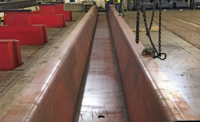A horizontally curved, precast- concrete, trapezoidal type of box-girder design that shaved some $9 million off an interchange project in Orlando, Fla., is attracting growing interest from the bridge engineering industry.
The recently completed $85-million Boggy Creek Interchange, near Orlando International Airport, includes 90 U-girders, on average 120 ft long and 135 tons, says Alberto Ribas, senior project engineer with A² Group Inc., the prime construction and engineering inspection provider for the Central Florida Expressway Authority (CFX).
Original plans called for the three flyover ramps to use curved steel-box girders. Three out of six bidders in 2012 offered redesigns using U-girders, for which the Precast/Prestressed Concrete Institute (PCI) in 2010 had created standard plans in collaboration with several Florida member companies.
In 2012, PCI also hosted a “TechnoQuest” forum in Denver, where the first iteration of the U-girder, designed by the Colorado Dept. of Transportation (CDOT), had been placed in the early 1990s. CFX, then called the Orlando Orange County Expressway Authority, attended that event, along with consultants and manufacturers from Florida and Texas, says Donald Budnovich, CFX resident engineer.
CFX eventually rebid the Boggy Creek job, now specifying that the structures use curved, precast girders. “CDOT did the U-girders as contractor-initiated changes, but we specified it here,” says Budnovich. “We are probably a little more conservative in design because of the owner’s interests and conventional design-bid-build.”
For example, Colorado’s version of the U-girders use a precast lift slab atop the beams, while CFX wanted it to be cast in place, Budnovich adds. “We’ve had [degradation] issues with precast lift slabs in Florida,” he says. “We didn’t want that on these flyovers.” The approximately 120-ft-long beams were segmented together 10 at a time, then post-tensioned.
Encouraged by the estimated $9 million in savings, CFX will use the U- girders on another interchange and on the $1.6-billion Wekiva Parkway, a 25-mile tolled beltway.
Beaming Prospects
Michael McMullen, now retired from CDOT, designed the first iteration of the curved U-girder, part cast-in-place and part precast, he says. The concept arose out of a desire for redeckable bridges over busy routes, a trait not possible with standard precast segmental construction, he says. Moreover, the Denver metro region had requirements that included trapezoidal girders, limited falsework locations and limited availability of trapezoidal steel-girder fabrication, he adds.
In 1993, PCI saw girders being precast on site because they were too heavy to transport from a yard, according to William Nickas, PCI managing director of transportation systems. Over the next decade, curved U-girders became viable due to developments such as reliable high-performance concrete, new field splicing and post-tensioning techniques, evolving forming systems and equipment, and bridge design software.
In 2004, industry members visited a flyover at Interstate 25/state Highway 270, located in Denver, featured the first plant-produced curved U-girder in the country. Subsequently, PCI formed a specific committee on curved concrete bridges and sets of standards for U-girders for specific regions of the country, says Nickas.
A PCI report in 2012 noted that the girders “allow a unified appearance throughout the project and an economical cost … because of its clean lines, non-varying bridge overhangs and ability to span greater lengths.”
The growing buzz prompted the Florida Dept. of Transportation to note the girder type on its innovation website. The contractor SEMA Construction, based in Colorado, had mentioned it to CFX years prior, recalls Budnovich. SEMA won the bid to build the Boggy Creek interchange, which opened in February.





Post a comment to this article
Report Abusive Comment